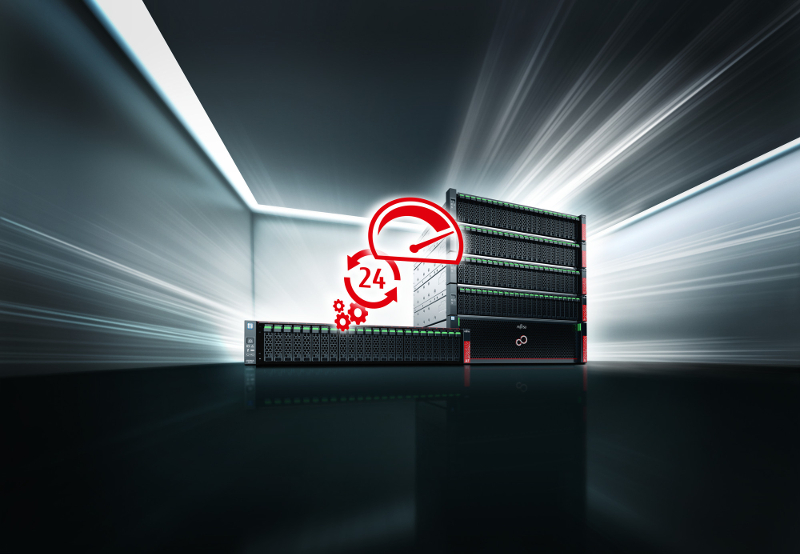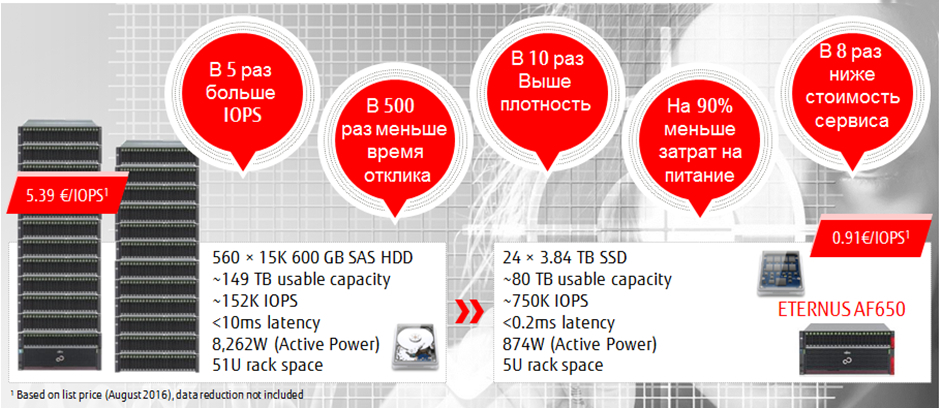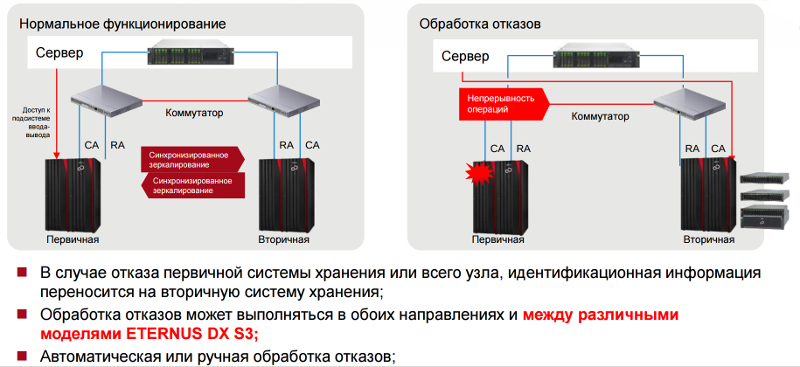Step to the “bright SSD future”
For several years now, as flash memory entered the market for storage systems, and not just came, but fixed on it. However, there is nothing surprising here. Suffice it to recall once again the undeniable advantages of flash drives (SSDs) over traditional hard drives (HDDs). Today we’ll talk about a completely new storage system in the Fujitsu line - ETERNUS AF, which uses only SSDs.

First of all, it's speed. The response time of modern SSDs is 500 times less than that of an HDD, which means instant access to data. EMLC enterprise-class flash drives are 100 times more reliable than hard drives, they consume significantly less power, and in terms of the number of input-output operations per second (IOPS), flash drives surpass hard drives by not even one, but several orders of magnitude. A significant drawback, which until recently hindered the advent of a “bright SSD future” in the data storage market, was the high cost of flash memory. But today, businesses need high-performance storage and access solutions. Data needs not only to be securely stored, but also to provide instant access to them. But if the data center infrastructure does not meet high requirements, the business will be idle, wasting time, customers and money. First of all, such requirements are made by enterprise-level transactional databases and analytical applications, virtualized server environments and workstations, as well as various cloud services. Accordingly, flash-based storage systems require less administration, configuration and performance tuning costs from the customer, while providing a higher level of Quality of Services. In a word, resources and money save time. while providing a higher level of Quality of Services. In a word, resources and money save time. while providing a higher level of Quality of Services. In a word, resources and money save time.
As we said above, until recently, the relative high cost of flash storage prevented their widespread distribution in the market, however, today the cost of SSDs is very close to the cost of high-speed hard drives, so manufacturers produce models of this class that can be positioned as systems primary and secondary level. These include Fujitsu's latest innovations - ETERNUS AF250 and ETERNUS AF650 storage systems based on Intel Xeon processors. These storage systems were created by the same development team that created ETERNUS DX disk arrays, which are already well known to customers, including Russian ones. In the new ETERNUS AF line, the same set of features is implemented as in DX - creating “snapshots”, cloning, mirroring, deduplication and compression, integration with VMware solutions, creation of fully automatic disaster-tolerant systems (Storage Cluster), an automatic level of Quality of Services, which allows working in heterogeneous environments with guaranteed performance, and much more. As for the performance comparison, if the classic Fujitsu ETERNUS DX600 storage system with SAS disks in the internal tests of the company shows 152 thousand input-output operations per second (IOPS) and shows a delay level of up to 10 milliseconds, then the new ETERNUS AF650 gives a multiple increase in speed 750,000 IOPS and 0.2 milliseconds of delay.

It should not be forgotten that today customers are increasingly paying money precisely for IOPS. Fujitsu developers managed to achieve this speed thanks to an improved algorithm for writing data to SSD media, an optimized Garbage Collection procedure that eliminates the need to write any data to disk at the time of “garbage collection”, as well as reducing the load on the controllers due to the ability to write data directly on an SSD, thereby offloading system memory.
An important reliability parameter of an SSD is the number of times a drive can be rewritten per day over a period of 5 years (DWPD). Many manufacturers of arrays consider exceeding the maximum number of records on SSD-carriers a non-warranty case requiring a paid replacement. At the same time, Fujitsu always acknowledges the failure of an SSD, except for obvious mechanical damage, as a warranty case. The current standard or extended warranty on ETERNUS AF storage systems means that all failed SSDs will be replaced by the manufacturer free of charge. This allows you to make the cost of maintaining storage infrastructure more transparent and predictable.
ETERNUS AF equipment is equipped in the basic supply with all the necessary software that allows you to manage licenses. Since Fujitsu has long abandoned licensing in terms of terabytes, customers will be able to predict the cost of ownership with a high degree of accuracy.
A few words about the hardware configuration of the ETERNUS AF250 and ETERNUS AF650. The youngest model supports 2 to 24 SSD disks, is equipped with a system memory of up to 64 GB, and the older model has 2 to 96 SSD disks and is equipped with a system memory of up to 256 GB. The ETERNUS AF250 model runs on a 6-core Intel Xeon processor with a frequency of 2 GHz, and the ETERNUS AF650 - 10-core, with a frequency of 3 GHz. The maximum amount of SSD disks that can already be installed in storage data today is 4 TB. But next year, Fujitsu promises to release larger drives.
We have already mentioned the disaster-proof Storage Cluster mechanism above. We will tell you more about it. It allows you to fully switch between two physical sites in the event of equipment failure on one of them. A similar feature is already well known to customers of ETERNUS hybrid and disk storage systems. A synchronous replica is built between the two arrays. In the event of a failure of one of the arrays, the second automatically addresses the same addresses and WWN ports that worked on the first array. For applications and systems working with this array, such a switch will be completely transparent and will happen in just a few seconds. At the request of the customer, you can combine flash and a regular disk array into Storage Cluster, although in terms of performance this solution, of course, will be inferior to the combination of two flash arrays. A similar opportunity can be used for ordinary business purposes, when you need to "transfer" data from one array to another.

Storage Cluster Workflow
A good way to optimize the use of storage space is deduplication and compression, which are also supported in ETERNUS AF. Deduplication is done on the fly, and the block size is 4K. Simultaneously with deduplication, the compression process also works. Of course, no one canceled the laws of physics, so the use of these tools can affect a certain decrease in productivity. As for the data decompression procedure, it is much faster than compression. It should also be noted that the most frequently used blocks are very likely to be in the system memory, which will significantly speed up both compression and decompression processes. The customer can also manually specify for which data or logical partitions deduplication and compression should be applied, and for which not.
The Quality of Services engine has long been used in traditional disk storage systems. The easiest way to configure it is to set priority levels for various logical volumes or data sets. If the customer requires a guaranteed SLA level in response time for any data, then thanks to the automatic reallocation of resources, this can also be realized.
Support for VMware virtual volumes in ETERNUS AF storage can be implemented using VVOL technology. It transfers mechanisms for creating “snapshots” and clones of virtual machines from the server to the disk array. Using VVOL allows you to create a virtual volume on this array in accordance with the policies that were set by the administrator. The same volume is used during the backup and recovery of virtual machines. Also, using VVOL on ETERNUS AF, you can create a complete clone of a virtual machine. In addition, VVOL provides visualization and monitoring tools for each individual virtual machine.
So, solutions like ETERNUS AF storage systems on the one hand increase the reliability of storage, and on the other - they allow you to implement high-speed characteristics that were recently available only for the most powerful Hi-End systems. At the same time, a huge number of background operations can be simplified and even automated, which significantly reduces the cost of maintaining equipment. Finally, such solutions bring the very “bright SSD future” that we spoke about at the very beginning, since the cost of one terabyte and the cost of IOPS are very close to the classic HDD products.

First of all, it's speed. The response time of modern SSDs is 500 times less than that of an HDD, which means instant access to data. EMLC enterprise-class flash drives are 100 times more reliable than hard drives, they consume significantly less power, and in terms of the number of input-output operations per second (IOPS), flash drives surpass hard drives by not even one, but several orders of magnitude. A significant drawback, which until recently hindered the advent of a “bright SSD future” in the data storage market, was the high cost of flash memory. But today, businesses need high-performance storage and access solutions. Data needs not only to be securely stored, but also to provide instant access to them. But if the data center infrastructure does not meet high requirements, the business will be idle, wasting time, customers and money. First of all, such requirements are made by enterprise-level transactional databases and analytical applications, virtualized server environments and workstations, as well as various cloud services. Accordingly, flash-based storage systems require less administration, configuration and performance tuning costs from the customer, while providing a higher level of Quality of Services. In a word, resources and money save time. while providing a higher level of Quality of Services. In a word, resources and money save time. while providing a higher level of Quality of Services. In a word, resources and money save time.
As we said above, until recently, the relative high cost of flash storage prevented their widespread distribution in the market, however, today the cost of SSDs is very close to the cost of high-speed hard drives, so manufacturers produce models of this class that can be positioned as systems primary and secondary level. These include Fujitsu's latest innovations - ETERNUS AF250 and ETERNUS AF650 storage systems based on Intel Xeon processors. These storage systems were created by the same development team that created ETERNUS DX disk arrays, which are already well known to customers, including Russian ones. In the new ETERNUS AF line, the same set of features is implemented as in DX - creating “snapshots”, cloning, mirroring, deduplication and compression, integration with VMware solutions, creation of fully automatic disaster-tolerant systems (Storage Cluster), an automatic level of Quality of Services, which allows working in heterogeneous environments with guaranteed performance, and much more. As for the performance comparison, if the classic Fujitsu ETERNUS DX600 storage system with SAS disks in the internal tests of the company shows 152 thousand input-output operations per second (IOPS) and shows a delay level of up to 10 milliseconds, then the new ETERNUS AF650 gives a multiple increase in speed 750,000 IOPS and 0.2 milliseconds of delay.

It should not be forgotten that today customers are increasingly paying money precisely for IOPS. Fujitsu developers managed to achieve this speed thanks to an improved algorithm for writing data to SSD media, an optimized Garbage Collection procedure that eliminates the need to write any data to disk at the time of “garbage collection”, as well as reducing the load on the controllers due to the ability to write data directly on an SSD, thereby offloading system memory.
An important reliability parameter of an SSD is the number of times a drive can be rewritten per day over a period of 5 years (DWPD). Many manufacturers of arrays consider exceeding the maximum number of records on SSD-carriers a non-warranty case requiring a paid replacement. At the same time, Fujitsu always acknowledges the failure of an SSD, except for obvious mechanical damage, as a warranty case. The current standard or extended warranty on ETERNUS AF storage systems means that all failed SSDs will be replaced by the manufacturer free of charge. This allows you to make the cost of maintaining storage infrastructure more transparent and predictable.
ETERNUS AF equipment is equipped in the basic supply with all the necessary software that allows you to manage licenses. Since Fujitsu has long abandoned licensing in terms of terabytes, customers will be able to predict the cost of ownership with a high degree of accuracy.
A few words about the hardware configuration of the ETERNUS AF250 and ETERNUS AF650. The youngest model supports 2 to 24 SSD disks, is equipped with a system memory of up to 64 GB, and the older model has 2 to 96 SSD disks and is equipped with a system memory of up to 256 GB. The ETERNUS AF250 model runs on a 6-core Intel Xeon processor with a frequency of 2 GHz, and the ETERNUS AF650 - 10-core, with a frequency of 3 GHz. The maximum amount of SSD disks that can already be installed in storage data today is 4 TB. But next year, Fujitsu promises to release larger drives.
We have already mentioned the disaster-proof Storage Cluster mechanism above. We will tell you more about it. It allows you to fully switch between two physical sites in the event of equipment failure on one of them. A similar feature is already well known to customers of ETERNUS hybrid and disk storage systems. A synchronous replica is built between the two arrays. In the event of a failure of one of the arrays, the second automatically addresses the same addresses and WWN ports that worked on the first array. For applications and systems working with this array, such a switch will be completely transparent and will happen in just a few seconds. At the request of the customer, you can combine flash and a regular disk array into Storage Cluster, although in terms of performance this solution, of course, will be inferior to the combination of two flash arrays. A similar opportunity can be used for ordinary business purposes, when you need to "transfer" data from one array to another.

Storage Cluster Workflow
A good way to optimize the use of storage space is deduplication and compression, which are also supported in ETERNUS AF. Deduplication is done on the fly, and the block size is 4K. Simultaneously with deduplication, the compression process also works. Of course, no one canceled the laws of physics, so the use of these tools can affect a certain decrease in productivity. As for the data decompression procedure, it is much faster than compression. It should also be noted that the most frequently used blocks are very likely to be in the system memory, which will significantly speed up both compression and decompression processes. The customer can also manually specify for which data or logical partitions deduplication and compression should be applied, and for which not.
The Quality of Services engine has long been used in traditional disk storage systems. The easiest way to configure it is to set priority levels for various logical volumes or data sets. If the customer requires a guaranteed SLA level in response time for any data, then thanks to the automatic reallocation of resources, this can also be realized.
Support for VMware virtual volumes in ETERNUS AF storage can be implemented using VVOL technology. It transfers mechanisms for creating “snapshots” and clones of virtual machines from the server to the disk array. Using VVOL allows you to create a virtual volume on this array in accordance with the policies that were set by the administrator. The same volume is used during the backup and recovery of virtual machines. Also, using VVOL on ETERNUS AF, you can create a complete clone of a virtual machine. In addition, VVOL provides visualization and monitoring tools for each individual virtual machine.
So, solutions like ETERNUS AF storage systems on the one hand increase the reliability of storage, and on the other - they allow you to implement high-speed characteristics that were recently available only for the most powerful Hi-End systems. At the same time, a huge number of background operations can be simplified and even automated, which significantly reduces the cost of maintaining equipment. Finally, such solutions bring the very “bright SSD future” that we spoke about at the very beginning, since the cost of one terabyte and the cost of IOPS are very close to the classic HDD products.
